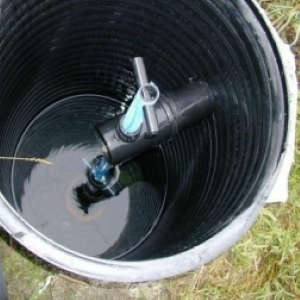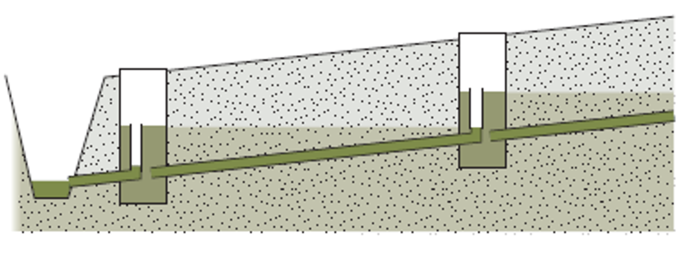Controlled drainage

Controlled drainage is a form of subsurface drainage, where the groundwater level is regulated with damming devices. When water is recharged it is called sub-irrigation. The measure can reduce greenhouse gas emission from organic soils and acid discharge from acid sulphate soils.
Controlled drainage regulates the subsurface drainage from the fields by means of damming devices installed in the control wells. This improves growth conditions and reduces nutrient leaching. With controlled drainage, the groundwater level can be kept occasionally higher than with conventional drainage, and as a result the soil moisture increases and the subsurface drainage decreases. Increased soil moisture improves plant water and nutrient uptake, increasing yields and reducing the amount of potentially leachable nutrients in the soil.
Localisation and implementation
Controlled drainage is best suited for fields with a maximum slope of 2%. The soil type must be very permeable to water, which is why silt loam, and coarser soil types as well as muddy clays are well suited for controlled drainage. Poorly permeable subsoil must be relatively close to the ground surface for dams to work.
Effects and maintenance
Compared to conventional drainage, controlled drainage reduces total runoff, nutrient leaching and rust formation. In acid sulphate soils, acid formation and leaching of metal compounds are reduced. The crop yield, in turn, increases and its quality improves.
To benefit the vegetation and the environment, the control drainage requires appropriate care (esp. dam height adjustment). Maintenance includes cleaning the wells and flushing pipes in rusty areas.

Controlled drainage - extended description
Controlled drainage is a specialized form of subsurface drainage, where the groundwater level is regulated with damming devices. Especially when water is added to the controlled drainage system, called sub-irrigation, it can significantly reduce harmful environmental impacts normally associated with subsurface drainage, such as greenhouse gas emission from organic soils and acid discharge from acid sulphate soils.
Description
Controlled drainage regulates the subsurface drainage from the fields by means of damming devices installed in the control wells. This improves growth conditions and reduces nutrient leaching. With controlled drainage, the groundwater level can be kept occasionally higher than with conventional drainage, and as a result the soil moisture increases and the subsurface drainage decreases. Increased soil moisture improves plant water and nutrient uptake, increasing yields and reducing the amount of potentially leachable nutrients in the soil.
Conventional subsurface drainage aims to remove water quickly from the soil in the event of rain, snow melting or frost thawing, to ensure sufficient soil bearing capacity to support field equipment and to prevent water logging. This kind of drainage is only required in the spring and autumn, and in the summertime there´s a risk of the soil draining too efficiently, resulting in the loss of too much water. Drainage waters also carry nutrients, resulting in nutrient loss in the field and eutrophication in the water bodies. With controlled drainage, the drainage depth can be adjusted according to weather conditions.
In controlled drainage, control wells are installed to the collector drain, and the amount of water drained from these wells is controlled by the means of damming devices. When water level rises above the dam height, excess is drained through the ditches. When the dams are removed, the drainage works like conventional drainage. The required amount of control wells depends on the slope of the field and on the design of the ditches.
When water is led back into the soil through the control wells and the drainage system, it is called sub-irrigation. Controlled drainage and sub-irrigation can also be practiced by damming the field- or main ditches.
Localisation and implementation
Controlled drainage is best suited for fields with a maximum slope of 2%, and 1 % for sub-irrigation. The soil type must be very permeable to water, which is why silt loam, and coarser soil types as well as muddy clays are well suited for controlled drainage. Poorly permeable subsoil must be relatively close below the depth of the drainage pipes for the system to work.
Field topography and slope should be carefully determined before installing controlled drainage. Soil type and hydraulic conductivity should be determined at least to drainage depth.
Controlled drainage can be implemented on an existing drainage system as well as a new installation. In the case of new subsurface drainage, the special needs of controlled drainage can be taken into account from the start, such as the position of pipes and wells relative to the slope of the field, and the distance, depth and slope of the pipes themselves.
A qualified drainage designer should design the system. The design should consider the existing drainage and its functionality, topography, soil type, hydraulic conductivity and groundwater level. According to them, drain placement, distance, depth, pipe size, flushing pipes, envelope material and control wells are designed. Topography, drain and well locations are marked on the design map. The designer should also make a cost estimate, list of required supplies and work plan. In the case on sub-irrigation, a water supply should be identified.
For the functionality of controlled drainage and sub-irrigation, the drainage pipes should run parallel to contours and their slope should be as small as possible. On the other hand, the slope needs to be sufficient to stop soil accumulating into the pipes. If the field surface is uneven, it´s a good idea to level it before installing controlled drainage. The envelope material prevents soil from entering the pipes, allowing water to flow freely. Especially in sub-irrigation, quality of envelope material is pronounced.
For controlled drainage and sub-irrigation, drainage pipes are installed closer together, to ensure even moisture during damming. The smaller distance between pipes also ensures efficient drainage in the event of heavy rain during damming, when ground water level is already high. If the drainage is designed as a new system, the distance should be 30 % smaller than recommended for conventional drainage in that field. If sub-irrigation is also implemented, the pipe distance can even be halved. If an existing drainage system is being converted to a controlled one, new drainage pipes should be installed between the existing ones, especially where water logging has been observed. When supplementary drains are installed, the size of the collector pipe should be checked and changed for a larger one if necessary.
A control well can be either plastic or concrete. Commercial control wells are available in plastic. There are numerous solutions available for adjusting the dam height, for both stepwise and continuous. The well lids should be easy to handle, and for safety reasons, there should be a separate cover plate under the lid. The control devices are usually manually operated. Automatic systems will no doubt become more common as technology advances and becomes more cost effective.
The amount of control wells depends primarily on the slope of the field. Typically, one well is required for every 1,5 ha of field. A steeper slope requires more wells and adds to the costs considerably. The well must be placed so that it doesn´t interfere with work in the field and can stay securely in place. To avoid frost damage, the well should have a solid foundation and be surrounded by a coarse material that doesn’t expand when freezing.
Water for sub-irrigation can be taken from the main ditch, a natural water body or a reservoir.
Effects, duration and maintenance
Compared to conventional drainage, controlled drainage reduces total runoff, nutrient leaching and rust formation. In acid sulphate soils, acid formation and leaching of metal compounds are reduced. The crop yield, in turn, increases and its quality improves.
To benefit the vegetation and the environment, the control drainage requires appropriate care (esp. dam height adjustment). Maintenance includes cleaning the wells and flushing pipes in rusty areas.
To realize the potential controlled drainage has for the crop and the environment, it requires appropriate maintenance. The drainage height is controlled according to weather, growing conditions and agricultural practices. The connection between the water level in the control well and water level in various parts of the field is a key factor in choosing the damming height. This connection varies for each field and requires careful monitoring especially in first few years. The goal is not to drain the field any more than necessary to achieve sufficient bearing capacity and growing conditions. To monitor groundwater level in the field, observation pipes should be installed halfway between drainage pipes.
In the spring damming height is determined by the bearing capacity required by field machinery. After sowing, the damming height should be increased as soon as possible to reserve spring moisture in the soil. For optimal root formation, the soil shouldn’t be too wet.
During the growing season, the damming height is determined by the requirements of the crop and should be monitored carefully and adjusted if necessary. Especially during the early growing season, the level can be kept quite high. Before harvest, the level is dropped to ensure bearing capacity, and to drain the soil in anticipation of heavy rainfall in the autumn.
In the autumn, the level is raised again to minimize nutrient runoff. In doing this, a balance must be found between minimizing drainage outflow and risking surface runoff.
For the winter, damming should be removed to prevent frost damage to the system. In mild winters with no risk of frost, the damming can be kept, but lowered to allow melting waters to drain.
Controlled drainage allows keeping the water table high during the growing season, while it can be lowered during times of traffic in the field. A high water table has been shown in research to significantly reduce greenhouse gas emissions from organic soil.
Costs and policy instruments
The expenses from controlled drainage are somewhat higher than conventional subsurface drainage. The main differences arise from the increased number of drains (smaller distance between drainage pipes), installation of the wells and damming devices and levelling of the soil surface. Annual maintenance causes expenses in the form of farmer´s own work hours.
In Finland, it is possible to apply for an investment subsidy for the installation of the drains, and on peatland fields and acid sulphate soils in a specified region for a special environmental subsidy for the maintenance costs, covering both the maintenance on controlled drainage and sub-irrigation.
Controlled drainage - links to resources
Pamphlets, reports, videos and websites
Videos, pamphlets etc. (in EN, FI, SE) - Educational material (Finnish Field Drainage Association)
Scientific papers
Carstensen, M.V., Børgesen, C.D., Ovesen, N.B., Poulsen, J.R., Hvid, S.K. and Kronvang, B. (2019), Controlled Drainage as a Targeted Mitigation Measure for Nitrogen and Phosphorus. J. Environ. Qual., 48: 677-685. DOI
Regina, K., Sheehy, J. & Myllys, M. 2015. Mitigating greenhouse gas fluxes from cultivated organic soils with raised water table. Mitigation and Adaptation Strategies for Global Change 20: 1529–1544. DOI
Yli-Halla, M., Virtanen, S., Regina, K. et al. Nitrogen stocks and flows in an acid sulfate soil. Environ Monit Assess 192, 751 (2020). DOI
Authors:
Helena Äijö and Minna Mäkelä, Finnish Field Drainage Association (FFDA), Finland.
Contact: Helena Äijö, FFDA, Finland. e-mail

